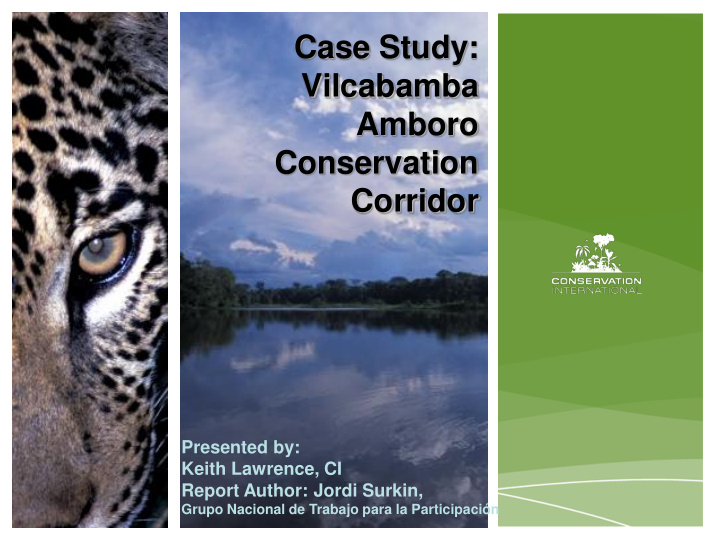



Case Study: Vilcabamba Amboro Conservation Corridor Presented by: Keith Lawrence, CI Report Author: Jordi Surkin, Grupo Nacional de Trabajo para la Participación
Presentation Outline CI’s approach to corridors & landscapes Background to the VACC 1. Getting started 2. Assessing the ecological landscape 3. Assessing protection & conservation status 4. Assessing resources & policies 5. Designing an integrated landscape 6,7 Strategies 8. Monitoring effectiveness
CI Definition of a Conservation Corridor “ A biologically and strategically defined sub-regional space selected as a unit for large- scale conservation planning and implementation purposes .” i.e. a much broader definition than some others use e.g. a “wildlife corridor”
Why have conservation corridors? Biodiversity: area-demanding & migratory species Ecological processes e.g. hydrology Resilience to change Opportunism Need to think about economics & land use Opportunity costs Conservation vs development Threats / pressures
Vilcabamba Amboro Conservation Corridor
Background to the VACC Also some of Amazon Wilderness Area From 200m to more than 6,000m 30 million hectares World records for taxa such as butterflies and birds Approximately 6,000 species of plants 145 globally threatened species
1. Getting started Late 80s: 2000: CI 1993, the 2 Tambopata- began governments signed Candamo reserved corridor a Cooperation zone established design work Agreement (through in Peru, near Amazon Cooperation Bolivian border Treaty) 2003: Corridor 1990s: Government & implementatio private organizations n, national / set up Tambopata- binational Madidi transborder workshops conservation complex
1. Getting started One of 1st corridors CI had an active role in Long history of cooperation between Peru & Bolivia Need to develop a shared understanding/ vision of the corridor This has been difficult to achieve in Andes corridors
Aims “…. a mosaic of parks, reserves and sustainable use areas, which is managed to: 1) Ensure the survival of the largest spectrum of species and habitats in the region, and 2) Contribute to regional sustainable development , by means of its biological richness and environmental services.” ( CEPF and CI, 2003b)
2. Assessing the ecological landscape More rigorous identification of scientific gaps & refinement of strategic planning: 2 scientific studies in 2004 and 2005 Identified: Species richness, endemism, conservation priorities (based on the IUCN globally threatened species) State of conservation suitability (for example, extent of habitat fragmentation / degradation) Social feasibility of protecting these areas & species
2. Assessing the ecological landscape Connectivity has two distinct meanings: 1. Maintain connectivity 2. Connect fragments Need to thoroughly assess & allow for the implications of climate change across the corridor
3. Assessing protection & conservation status Diverse array of types of Protected Area Some very large Numerous indigenous territories or reserves PAs have a variable level of management effectiveness: often underfunded, understaffed & lack of adequate infrastructure
4. Assessing resources & policies Weak policy frameworks … but improving Overlapping land & resource access rights
Policies / governance: Lessons Need to integrate corridor planning into policies & planning instruments from local to national levels … and in agendas of partners In Bolivia, VACC has given local actors a sense of responsibility for conservation action Full involvement of all actors in corridor planning & implementation processes is fundamental Greater inter & intra sectoral coordination will help, especially with development oriented partners
4. Assessing resources & policies Forest conversion to agricultural land / pasture Legal & illegal logging Mining, oil & gas concessions cover most of the corridor Cultural diversity, poverty & a growing population Recently, nature tourism has grown
5. Designing an integrated landscape Corridor design often driven more by donor priorities than a systematic analysis of conservation priorities Require strategies that take account of biological, social and political context E.g. VACC has characteristics of a wilderness area – requires different strategies to highly fragmented corridors (which would focus more on linking PAs through sustainable economic activities)
6 & 7. Strategies Municipal Land Use Planning: CI-Bolivia developed the land use plan for the Municipality of Apolo Can serve to harmonize conservation with the needs and objectives of communities; Increases local knowledge of conservation
6 & 7. Strategies Community based ecotourism (Chalalan) Need to incorporate a value chain approach as well as a heavy emphasis on training to be successful; Alliances with the private sector & government are key to success
6 & 7. Strategies Management plan for Reserva de la Biosfera- TCO indigenous territory (with WCS) - livelihoods strategy - participatory mapping - Key opportunity for connectivity
6 & 7. Strategies Brochures & a film “Treasures without Borders” & “the green tent” - Communications need on-going & continued support - PAs need to budget for communications & environmental education
6 & 7. Strategies Transboundary coordination: Binational Technical Committee Need to understand dynamics of international relations & political realities; Exchanging experiences is a great way to strengthen transboundary coordination
8. Monitoring effectiveness No ME system in place at corridor scale CI has outcomes monitoring & intervention monitoring processes, plus indicators for donors: Species & site level Fragmentation indices Edge effects % of area zoned Governance Whether policies changed … Bolivian government has Medicion de efectividad de manaejo of PAs, based on TNC scorecard
Thank you! Keith Lawrence k.lawrence@conservation.org
Join CORNET: the Corridors Network New email discussion list on conservation within corridors or landscapes – ask questions – hear about new publications / events – promote your work & publications – an open space to express opinions – discussions on specific topics http://corridors.conservation.org klawrence@conservation.org
Recommend
More recommend